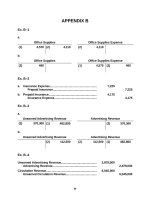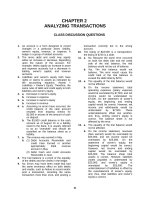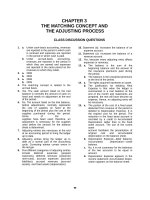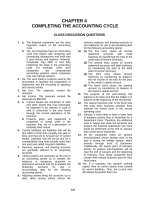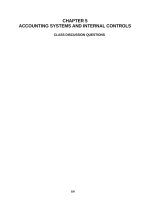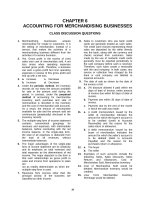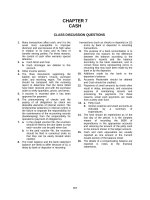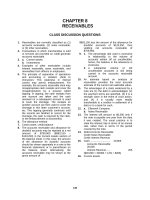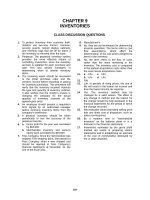Solution manual accounting 21e by warreni ch 08
Bạn đang xem bản rút gọn của tài liệu. Xem và tải ngay bản đầy đủ của tài liệu tại đây (140.88 KB, 42 trang )
CHAPTER 8
RECEIVABLES
CLASS DISCUSSION QUESTIONS
1. Receivables are normally classified as (1)
accounts receivable, (2) notes receivable,
or (3) other receivables.
2. Transactions in which merchandise is sold
or services are provided on credit generate
accounts receivable.
3. a. Current assets
b. Investments
4. Examples of other receivables include
interest receivable, taxes receivable, and
receivables from officers or employees.
5. The principle of separation of operations
and accounting is violated. (Note to
Instructors: This weakness in internal
control may permit embezzlement. For
example, the accounts receivable clerk may
misappropriate cash receipts and cover the
misappropriation by a process called
lapping. In lapping, the cash receipts from
one account are taken and the cash
received on a subsequent account is used
to cover the shortage. The receipts on
another account are then used to cover the
shortage in this latter customer’s account,
etc. This lapping generally continues until
the records are falsified to correct for the
shortage, the cash is returned by the clerk,
or the embezzlement is discovered.)
6. The allowance method
7. Contra asset, credit balance
8. The accounts receivable and allowance for
doubtful accounts may be reported at a net
amount
of
$759,900
($883,150
–
$123,250) in the Current Assets section of
the balance sheet. In this case, the amount
of the allowance for doubtful accounts
should be shown separately in a note to the
financial statements or in parentheses on
the balance sheet. Alternatively, the
accounts receivable may be shown at the
gross amount of
$883,150 less the amount of the allowance for
doubtful accounts of $123,250, thus
yielding net accounts receivable of
$759,900.
9. 1. The percentage rate used is excessive
in relationship to the volume of
accounts written off as uncollectible;
hence, the balance in the allowance is
excessive.
2. A
substantial
volume
of
old
uncollectible accounts is still being
carried in the accounts receivable
account.
10. An estimate based on analysis of
receivables provides the most accurate
estimate of the current net realizable value.
11. The advantages of a claim evidenced by a
note are (1) the debt is acknowledged, (2)
the payment terms are specified, (3) it is a
stronger claim in the event of court action,
and (4) it is usually more readily
transferable to a creditor in settlement of a
debt or to a bank for cash.
12. a. Ellsworth Company
b. Notes Receivable
13. The interest will amount to $6,300 only if
the note is payable one year from the date
it was created. The usual practice is to
state the interest rate in terms of an annual
rate, rather than in terms of the period
covered by the note.
14. Debit Accounts Receivable
Credit Notes Receivable
Credit Interest Revenue
15. Cash............................... 20,806
Accounts Receivable
20,600
Interest Revenue......
206
($20,600 × 30/360 × 12% = $206)
16. Current assets
145
EXERCISES
Ex. 8–1
a. Inappropriate. Since Fridley has a large number of credit sales supported by
promissory notes, a notes receivable ledger should be maintained. Failure to
maintain a subsidiary ledger when there are a significant number of notes
receivable transactions violates the internal control procedure that mandates
proofs and security. Maintaining a notes receivable ledger will allow Fridley to
operate more efficiently and will increase the chance that Fridley will detect
accounting errors related to the notes receivable. (The total of the accounts in
the notes receivable ledger must match the balance of notes receivable in the
general ledger.)
b. Inappropriate. The procedure of proper separation of duties is violated. The
accounts receivable clerk is responsible for too many related operations. The
clerk also has both custody of assets (cash receipts) and accounting
responsibilities for those assets.
c. Appropriate. The functions of maintaining the accounts receivable account in
the general ledger should be performed by someone other than the accounts
receivable clerk.
d. Appropriate. Salespersons should not be responsible for approving credit.
e. Appropriate. A promissory note is a formal credit instrument that is frequently
used for credit periods over 45 days.
Ex. 8–2
a. Hotel accounts and notes receivable:
$3,256,000 ÷ $75,796,000 = 4.3%
b. Casino accounts receivable:
$6,654,000 ÷ $26,334,000 = 25.3%
c. Casino operations experience greater bad debt risk than do hotel operations,
since it is difficult to control the creditworthiness of customers entering the
casino. In addition, individuals who may have adequate creditworthiness may
overextend themselves and lose more than they can afford if they get caught
up in the excitement of gambling.
Ex. 8–3
Account
Bear Creek Body Shop
First Auto
Kaiser Repair
Master’s Auto Repair
Richter Auto
Sabol’s
Uptown Auto
Westside Repair & Tow
Due Date
June 8
July 3
March 20
May 15
June 18
April 12
May 8
May 31
Number of Days Past Due
53 (22 + 31)
28
133 (11 + 30 + 31 + 30 + 31)
77 (16 + 30 + 31)
43 (12 + 31)
110 (18 + 31 + 30 + 31)
84 (23 + 30 + 31)
61 (30 + 31)
Ex. 8–4
a.
Customer
Janzen Industries
Kuehn Company
Mauer Inc.
Pollack Company
Simrill Company
Due Date
Number of Days Past Due
August 29
93 days (2 + 30 + 31 + 30)
September 388 days (27 + 31 + 30)
October 21
40 days (10 + 30)
November 23
7 days
December 3
Not past due
b.
Customer
Aaker Brothers Inc.
Aitken Company
Aging of Accounts Receivable
November 30
Days Past Due
Not Past
Balance
Due
1–30
31–60
61–90
2,000
1,500
Over
90
2,000
1,500
~~~~~~~~~~~~~~~~~~~~~~~~~~~~~~~~~~~~~~~~~~~~~~~~~~~~~~~~~~~~~~~~~~
Zollo Company
Subtotals
Janzen Industries
Keuhn Company
Mauer Inc.
Pollack Company
Simrill Company
Totals
5,000
972,500
40,000
8,500
18,000
6,500
7,500
1,053,000
640,000 180,000
5,000
78,500
42,300
31,700
40,000
8,500
18,000
6,500
7,500
647,500 186,500
96,500
50,800
71,700
Ex. 8–5
Days Past Due
Balance
Total receivables
Percentage
Uncollectible
Allowances for
Doubtful Accounts
Not Past
Due
1–30
31–60
61–90
Over
90
$1,053,000 $647,500 $186,500 $96,500 $50,800 $71,700
1%
$60,495
$6,475
4%
$7,460
8%
20%
40%
$7,720 $10,160 $28,680
Ex. 8–6
Nov. 30
Uncollectible Accounts Expense.......................
Allowances for Doubtful Accounts.............
53,315*
53,315
*$60,495 – $7,180 = $53,315
Ex. 8–7
Estimated Uncollectible Accounts
Age Interval
Balance
Percent
Amount
Not past due...............................
1–30 days past due....................
31–60 days past due..................
61–90 days past due..................
91–180 days past due................
Over 180 days past due.............
Total.......................................
$450,000
110,000
51,000
12,500
7,500
5,500
$636,500
2%
4
6
20
60
80
$ 9,000
4,400
3,060
2,500
4,500
4,400
$27,860
Ex. 8–8
2006
Dec. 31 Uncollectible Accounts Expense.......................
Allowance for Doubtful Accounts.................
*$27,860 + $1,575 = $29,435
29,435*
29,435
Ex. 8–9
a. $17,875
b. $13,600
c. $35,750
d. $41,450
Ex. 8–10
a.
Allowance for Doubtful Accounts................................
Accounts Receivable...............................................
7,130
b. Uncollectible Accounts Expense..................................
Accounts Receivable...............................................
7,130
7,130
7,130
Ex. 8–11
Feb. 20
20
May 30
30
Aug. 3
3
Accounts Receivable—Darlene Brogan............
Sales..............................................................
12,100
Cost of Merchandise Sold..................................
Merchandise Inventory.................................
7,260
Cash.....................................................................
Accounts Receivable—Darlene Brogan......
6,000
Allowance for Doubtful Accounts......................
Accounts Receivable—Darlene Brogan......
6,100
Accounts Receivable—Darlene Brogan............
Allowance for Doubtful Accounts...............
6,100
Cash.....................................................................
Accounts Receivable—Darlene Brogan......
6,100
12,100
7,260
6,000
6,100
6,100
6,100
Ex. 8–12
July
6
6
Sept. 12
12
Dec. 20
20
Accounts Receivable—Dr. Jerry Jagers............
Sales..............................................................
18,500
Cost of Merchandise Sold..................................
Merchandise Inventory.................................
11,100
Cash.....................................................................
Accounts Receivable—Dr. Jerry Jagers.....
9,000
Uncollectible Accounts Expense.......................
Accounts Receivable—Dr. Jerry Jagers.....
9,500
Accounts Receivable—Dr. Jerry Jagers............
Uncollectible Accounts Expense................
9,500
Cash.....................................................................
Accounts Receivable—Dr. Jerry Jagers.....
9,500
Ex. 8–13
$223,900 [$212,800 + $112,350 – ($4,050,000 × 2 1/2%)]
Ex. 8–14
a. $257,100 [$262,300 + $114,800 – ($4,800,000 × 2 1/2%)]
b. $5,900 Dr. [($101,250 – $112,350) + ($120,000 – $114,800)]
18,500
11,100
9,000
9,500
9,500
9,500
Ex. 8–15
a.
b.
c.
d.
e.
Due Date
Aug. 31
Dec. 28
Nov. 30
May 5
July 19
Interest
$120
480
250
150
100
Ex. 8–16
a. August 8
b. $24,480
c. (1) Notes Receivable......................................................
Accounts Rec.—Magpie Interior Decorators.....
(2) Cash..........................................................................
Notes Receivable................................................
Interest Revenue.................................................
24,000
24,000
24,480
24,000
480
Ex. 8–17
1.
2.
3.
4.
5.
6.
Sale on account.
Cost of merchandise sold for the sale on account.
A sales return or allowance.
Cost of merchandise returned.
Note received from customer on account.
Note dishonored and charged maturity value of note to customer’s account
receivable.
7. Payment received from customer for dishonored note plus interest earned
after due date.
Ex. 8–18
2005
Dec. 13
31
31
2006
Apr. 12
Notes Receivable................................................
Accounts Receivable—Visage Co...............
25,000
25,000
Interest Receivable.............................................
Interest Revenue..........................................
75*
Interest Revenue.................................................
Income Summary..........................................
75
Cash.....................................................................
Notes Receivable..........................................
Interest Receivable.......................................
Interest Revenue..........................................
25,500
75
75
25,000
75
425
*$25,000 × 0.06 × 18/360 = $75
Ex. 8–19
July
Oct.
Nov.
8
6
5
Notes Receivable................................................
Accounts Receivable—Pennington Co.......
30,000.00
Accounts Receivable—Pennington Co.............
Notes Receivable..........................................
Interest Revenue..........................................
30,600.00
Cash.....................................................................
Accounts Receivable—Pennington Co.......
Interest Revenue..........................................
30,855.00
*$30,600 × 0.10 × 30/360 = $255.00
30,000.00
30,000.00
600.00
30,600.00
255.00*
Ex. 8–20
Mar.
1
18
Apr. 30
June 16
July 11
Notes Receivable................................................
Accounts Receivable—Absaroka Co..........
15,000
Notes Receivable................................................
Accounts Receivable—Sturgis Co..............
12,000
Accounts Receivable—Absaroka Co.................
Notes Receivable..........................................
Interest Revenue..........................................
15,125
Accounts Receivable—Sturgis Co.....................
Notes Receivable..........................................
Interest Revenue..........................................
12,270
Cash.....................................................................
Accounts Receivable—Absaroka Co..........
Interest Revenue..........................................
15,367
15,000
12,000
15,000
125
12,000
270
15,125
242*
*$15,125 × 0.08 × 72/360 = $242
Oct. 12
Allowance for Doubtful Accounts......................
Accounts Receivable—Sturgis Co..............
12,270
12,270
Ex. 8–21
1. The interest receivable should be reported separately as a current asset. It
should not be deducted from notes receivable.
2. The allowance for doubtful accounts should be deducted from accounts
receivable.
A corrected partial balance sheet would be as follows:
PEMBROKE COMPANY
Balance Sheet
July 31, 2006
Assets
Current assets:
Cash.............................................................................
Notes receivable.........................................................
Accounts receivable...................................................
Less allowance for doubtful accounts..............
Interest receivable......................................................
$ 43,750
300,000
$576,180
71,200
504,980
18,000
Ex. 8–22
a. 2003:
2002:
53.0 {$9,953,530 ÷ [($216,200 + $159,477) ÷ 2]}
44.8 {$9,518,231 ÷ [($159,477 + $265,515) ÷ 2]}
b. The accounts receivable turnover indicates an increase in the efficiency of
collecting accounts receivable by increasing from 44.8 to 53.0, a favorable
trend. Before reaching a more definitive conclusion, the ratios should be
compared with industry averages and similar firms.
Ex. 8–23
a. 2003:
2002:
7.9 days [$216,200 ÷ ($9,953,530 ÷ 365)]
6.1 days [$159,477 ÷ ($9,518,231 ÷ 365)]
b. The number of days’ sales in receivables indicates a decrease in the efficiency
of collecting accounts receivable by increasing from 6.1 days to 7.9 days, an
unfavorable trend. Before reaching a more definitive conclusion, the ratios
should be compared with industry averages and similar firms.
Ex. 8–24
a. 2002:
2001:
108.2 {$9,363,000 ÷ [($79,000 + $94,000) ÷ 2]}
99.6 {$10,105,000 ÷ [($94,000 + $109,000) ÷ 2]}
b. 2002:
2001:
3.1 days [$79,000 ÷ ($9,363,000 ÷ 365)]
3.4 days [$94,000 ÷ ($10,105,000 ÷ 365)]
c. The accounts receivable turnover indicates a slight increase in the efficiency
of collecting accounts receivable by increasing from 99.6 to 108.2, a favorable
trend. The number of days’ sales in receivables decreased from 3.4 days to 3.1
days, also indicating a favorable trend in collections of receivables. Before
reaching a more definitive conclusion, both ratios should be compared with
those of past years, industry averages, and similar firms.
Note to Instructors: The high accounts receivable turnover and low number of
days’ sales in receivables suggests that most of The Limited’s sales are cash
sales, such as those from MasterCard and VISA.
Appendix Ex. 8–25
a. $20,300
b. 60 days
c. $271 ($20,300 × 0.08 × 60/360)
d. $20,029 ($20,300 – $271)
e.
Cash................................................................................
Interest Revenue......................................................
Notes Receivable......................................................
20,029
29
20,000
Appendix Ex. 8–26
June 1
July
1
Notes Receivable................................................
Accounts Receivable—Rhodes Co.............
60,000
Cash.....................................................................
Notes Receivable..........................................
Interest Revenue..........................................
60,344*
60,000
60,000
344
*$60,800 – ($60,800 × 0.09 × 30/360) = $60,344
31
Aug. 30
Accounts Receivable—Rhodes Co....................
Cash..............................................................
61,000
Cash.....................................................................
Accounts Receivable—Rhodes Co.............
Interest Revenue .........................................
61,610*
*$61,000 + ($61,000 × 0.12 × 30/360) = $61,610
61,000
61,000
610
PROBLEMS
Prob. 8–1A
2.
2006
Mar. 15
15
Apr. 16
16
July 20
Oct. 31
31
Dec. 31
31
31
Cash.....................................................................
Accounts Receivable—Bimba Co................
11,100
Allowance for Doubtful Accounts......................
Accounts Receivable—Bimba Co................
7,400
Accounts Receivable—Tom Miner.....................
Allowance for Doubtful Accounts...............
5,782
Cash.....................................................................
Accounts Receivable—Tom Miner..............
5,782
Allowance for Doubtful Accounts......................
Accounts Receivable—Martz Co.................
5,500
Accounts Receivable—Two Bit Saloon Co........
Allowance for Doubtful Accounts...............
6,100
Cash.....................................................................
Accounts Receivable—Two Bit Saloon Co.
6,100
Allowance for Doubtful Accounts......................
Accounts Receivable—Asche Co................
Dorsch Co..............
Krebs Distributors.
J. J. Levi.................
9,250
Uncollectible Accounts Expense.......................
Allowance for Doubtful Accounts...............
11,918
Income Summary................................................
Uncollectible Accounts Expense................
11,918
11,100
7,400
5,782
5,782
5,500
6,100
6,100
950
4,600
2,500
1,200
11,918
11,918
Prob. 8–1A Concluded
1. and 2.
Allowance for Doubtful Accounts
Date
2006
Jan.
Mar.
Apr.
July
Oct.
Dec.
1
15
16
20
31
31
31
Item
Balance....................
.................................
.................................
.................................
.................................
.................................
.................................
115
Balance
Cr.
Dr.
Cr.
Dr.
.............
7,400
.............
5,500
.............
9,250
.............
.............
.............
5,782
.............
6,100
.............
11,918
.............
.............
.............
.............
.............
.............
.............
Income Summary
2006
Dec. 31
.................................
313
11,918
.............
11,918
Uncollectible Accounts Expense
2006
Dec. 31
31
.................................
.................................
3. $522,050 ($535,750 – $13,700)
4. a. $15,500 ($3,100,000 × 0.005)
b. $17,282 ($15,500 + $1,782)
c. $518,468 ($535,750 – $17,282)
12,050
4,650
10,432
4,932
11,032
1,782
13,700
.............
718
11,918
.............
.............
11,918
11,918
—
.............
—
Prob. 8–2A
1.
Customer
Able Sports & Flies
Red Tag Sporting Goods
Highlite Flies
Midge Co.
Snake River Outfitters
Pheasant Tail Sports
Big Sky Sports
Ross Sports
Sawyer’s Pheasant Tail
Tent Caddis Outfitters
Wulff Company
Zug Bug Sports
Due Date
June 15, 2006
July 28, 2006
Sept. 11, 2006
Sept. 30, 2006
Oct. 7, 2006
Oct. 27, 2006
Oct. 30, 2006
Nov. 18, 2006
Nov. 26, 2006
Nov. 29, 2006
Dec. 10, 2006
Jan. 6, 2007
Number of Days Past Due
199 days (15 + 31 + 31 + 30 + 31 + 30 + 31)
156 days (3 + 31 + 30 + 31 + 30 + 31)
111 days (19 + 31 + 30 + 31)
92 days (31 + 30 + 31)
85 days (24 + 30 + 31)
65 days (4 + 30 + 31)
62 days (1 + 30 + 31)
43 days (12 + 31)
35 days (4 + 31)
32 days
21 days
Not past due
Prob. 8–2A Concluded
2. and 3.
Aging of Accounts Receivable
December 31, 2006
Days Past Due
Customer
Alpha Fishery
Brown Trout Sports
Not Past
Balance
Due
5,000
5,000
6,400
1–30
31–60
61–90
91–120
Over
120
6,400
~~~~~~~~~~~~~~~~~~~~~~~~~~~~~~~~~~~~~~~~~~~~~~~~~~~~~~~~~~~~~~~~~~~~~~~~
Zinger Sports
2,900
Subtotals
580,000
Able Sports & Flies
3,500
Red Tag Sporting Goods 4,000
Highlite Flies
2,500
Midge Co.
3,100
Snake River Outfitters
4,500
Pheasant Tail Sports
1,600
Big Sky Sports
2,000
Ross Sports
500
Sawyer’s Pheasant Tail
2,800
Tent Caddis Outfitters
3,500
Wulff Company
1,000
Zug Bug Sports
6,200
Totals
615,200
Percentage Uncollectible
Estimate of Doubtful
Accounts
65,212
248,600
2,900
147,250
98,750
29,950
22,150
3,500
4,000
2,500
3,100
4,500
1,600
2,000
500
2,800
3,500
1,000
6,200
254,800
1%
2,548
148,250 105,550 41,400 35,550
4%
8%
25%
40%
5,930
8,444
4. Uncollectible Accounts Expense...................................
Allowance for Doubtful Accounts............................
*$65,212 + $2,800
33,300
10,350 14,220
29,650
80%
23,720
68,012*
68,012
Prob. 8–3A
1.
Year
1st
2nd
3rd
4th
Uncollectible Accounts Expense
Increase
Expense
Expense
(Decrease)
Actually
Based on
in Amount
Reported
Estimate
of Expense
$3,500
3,250
6,300
8,400
$ 6,375
7,200
9,000
13,500
$2,875
3,950
2,700
5,100
Balance of
Allowance
Account,
End of Year
$ 2,875
6,825
9,525
14,625
2. Yes. The actual write-offs of accounts originating in the first two years are
reasonably close to the expense that would have been charged to those years
on the basis of 3/4% of sales. The total write-off of receivables originating in
the first year amounted to $6,200 ($3,500 + $1,900 + $800), as compared with
uncollectible accounts expense, based on the percentage of sales, of $6,375.
For the second year, the comparable amounts were $7,650 ($1,350 + $4,500 +
$1,800) and $7,200.
Prob. 8–4A
1.
Note
(a)
Due Date
(1)
(2)
(3)
(4)
(5)
(6)
May 6
July 18
Dec. 28
Dec. 30
Jan. 18
Jan. 22
2.
Dec. 28
3.
Dec. 31
4.
Jan. 18
22
(b)
Interest Due at Maturity
$240
126
204
405
120
120
Accounts Receivable..........................................
Notes Receivable..........................................
Interest Revenue..........................................
10,404
Interest Receivable.............................................
Interest Revenue..........................................
$12,000 × 0.06 × 42/360 = $ 84
$16,000 × 0.09 × 8/360 =
32
Total
$116
116
Cash.....................................................................
Notes Receivable..........................................
Interest Receivable.......................................
Interest Revenue..........................................
12,120
Cash.....................................................................
Notes Receivable..........................................
Interest Receivable.......................................
Interest Revenue..........................................
16,120
10,200
204
116
12,000
84
36
16,000
32
88
Prob. 8–5A
June 4
July 15
Aug. 3
Sept. 1
Oct. 31
Nov.
5
12
30
Dec.
5
30
Notes Receivable................................................
Accounts Receivable...................................
18,800
Notes Receivable................................................
Accounts Receivable...................................
27,000
Cash.....................................................................
Notes Receivable..........................................
Interest Revenue..........................................
19,082
Notes Receivable................................................
Accounts Receivable...................................
24,000
Cash.....................................................................
Notes Receivable..........................................
Interest Revenue..........................................
24,360
Notes Receivable................................................
Accounts Receivable...................................
9,600
Cash.....................................................................
Notes Receivable..........................................
Interest Revenue..........................................
27,900
Notes Receivable................................................
Accounts Receivable...................................
15,000
Cash.....................................................................
Notes Receivable..........................................
Interest Revenue..........................................
9,656
Cash.....................................................................
Notes Receivable..........................................
Interest Revenue..........................................
15,125
18,800
27,000
18,800
282
24,000
24,000
360
9,600
27,000
900
15,000
9,600
56
15,000
125
Prob. 8–6A
Jan. 10
Feb.
4
4
12
12
Mar.
6
14
Apr. 10
May
5
13
June 12
July
9
Notes Receivable................................................
Cash..............................................................
12,000
Accounts Receivable—Emerson and Son.........
Sales..............................................................
24,000
Cost of Merchandise Sold..................................
Merchandise Inventory.................................
14,400
Accounts Receivable—Gwyn Co.......................
Sales..............................................................
25,000
Cost of Merchandise Sold..................................
Merchandise Inventory.................................
15,000
Notes Receivable................................................
Accounts Receivable—Emerson and Son. .
24,000
Notes Receivable................................................
Accounts Receivable—Gwyn Co.................
25,000
Notes Receivable................................................
Cash.....................................................................
Notes Receivable..........................................
Interest Revenue..........................................
12,000
240
Cash.....................................................................
Notes Receivable..........................................
Interest Revenue..........................................
24,240
Accounts Receivable—Gwyn Co.......................
Notes Receivable..........................................
Interest Revenue..........................................
25,500
Cash.....................................................................
Accounts Receivable—Gwyn Co.................
Interest Revenue..........................................
($25,500 × 0.12 × 30/360 = $255)
25,755
Cash.....................................................................
Notes Receivable..........................................
Interest Revenue..........................................
12,270
12,000
24,000
14,400
25,000
15,000
24,000
25,000
12,000
240
24,000
240
25,000
500
25,500
255
12,000
270
Prob. 8–6A Continued
Aug. 24
24
Sept. 3
Accounts Receivable—Haggerty Co.................
Sales..............................................................
10,200
Cost of Merchandise Sold..................................
Merchandise Inventory.................................
6,000
Cash.....................................................................
Sales Discounts..................................................
Accounts Receivable—Haggerty Co...........
10,098
102
10,200
6,000
10,200
Prob. 8–6A Continued
This solution is applicable only if the P.A.S.S. Software that accompanies the text
is used.
RIMROCK CO.
Income Statement
For the Year Ended December 31, 20—
Operating revenue:
Sales...............................................................
Less: Sales returns and allowance.............
Sales discounts.................................
Net sales...............................................................
Cost of merchandise sold....................................
Gross profit...........................................................
Operating expenses:
Sales salaries expense..................................
Advertising expense.....................................
Miscellaneous selling expense....................
Office salaries expense.................................
Rent expense.................................................
Miscellaneous administrative expense........
Total operating expenses......................
Net income from operations................................
Other revenue:
Interest revenue.............................................
Net income............................................................
$219,200
(10,000)
(1,302)
$207,898
84,413
$123,485
105.44
(4.81)
(0.63)
100.00
40.60
59.40
77,950
$ 45,535
19.48
3.85
0.24
7.94
5.89
0.10
37.49
21.90
1,505
$ 47,040
0.72
22.63
$ 40,500
8,000
500
16,500
12,250
200
Prob. 8–6A Concluded
This solution is applicable only if the P.A.S.S. Software that accompanies the text
is used.
RIMROCK CO.
Statement of Owner’s Equity
For the Year Ended December 31, 20—
Sophia Dubra, capital (beg. of year).................................
Net income for the year.....................................................
Less: Withdrawals.............................................................
Increase in capital..............................................................
Sophia Dubra, capital (end of year)..................................
$100,000
$47,040
30,000
17,040
$117,040
RIMROCK CO.
Balance Sheet
December 31, 20—
Assets
Cash.....................................................................................................
Accounts receivable...........................................................................
Merchandise inventory.......................................................................
Total assets....................................................................................
$ 98,940
24,500
28,600
$152,040
Liabilities
Accounts payable...............................................................................
$ 35,000
Owner's Equity
Sophia Dubra, capital..........................................................................
Total liabilities and owner’s equity...............................................
117,040
$152,040
Prob. 8–1B
2.
2006
Feb. 24
24
Mar. 29
July 10
10
Sept. 8
8
Dec. 31
31
31
Accounts Receivable—Dina Ibis........................
Allowance for Doubtful Accounts...............
1,025
Cash.....................................................................
Accounts Receivable—Dina Ibis.................
1,025
Allowance for Doubtful Accounts......................
Accounts Receivable—Hoxsey Co..............
7,500
Cash.....................................................................
Accounts Receivable—Foust Co................
4,800
Allowance for Doubtful Accounts......................
Accounts Receivable—Foust Co................
7,200
Accounts Receivable—Louis Sabo....................
Allowance for Doubtful Accounts...............
1,200
Cash.....................................................................
Accounts Receivable—Louis Sabo.............
1,200
Allowance for Doubtful Accounts......................
Accounts Receivable—Emery Co...............
Darigold Co............
Zheng Furniture.....
Carey Wenzel.........
20,905
Uncollectible Accounts Expense.......................
Allowance for Doubtful Accounts...............
35,380
Income Summary................................................
Uncollectible Accounts Expense................
35,380
1,025
1,025
7,500
4,800
7,200
1,200
1,200
8,050
6,260
3,775
2,820
35,380
35,380
